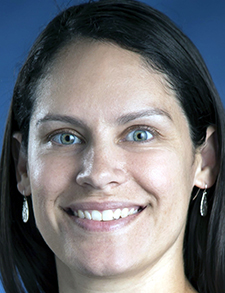
Dr. Cantu
Presenters: Cori Grant, MD, Purvi Patel, MD, and Molly Gleason, OTR/L
Rates of mental health issues and suicide in children have been rising for at least a decade, but since the summer of 2020 there has been a significant increase in mental health patient volumes, an increase in the severity of symptoms, and less access to outpatient psychiatric resources—8% of U.S. states report a shortage of psychiatric beds. Patients with autism spectrum disorders (ASD) have significantly more psychiatric admissions than children without. ASD and intellectual disability (ID) are the top two predictors for emergency department (ED) boarding. Typical pediatric inpatient psychiatric units do not meet the needs of children with ASD or ID. Models for best practice include an interdisciplinary team (including psychiatry, nursing, pediatrics, social work, board-certified behavioral analyst, speech therapy, and occupational therapy), autism-specific programming, and a specially designed milieu.
“Boarding” occurs when the decision has been made to admit a patient to inpatient psychiatry, but a bed is not currently available, so the patient remains in an ED or acute medical facility. The average boarding time for youth has doubled, with more than half of patients boarding for more than two days (the Joint Commission recommends boarding times of fewer than four hours).
Ancillary providers such as occupational therapists (OTs) can work with hospitalists to help mediate disruptive behavior by understanding and modifying aspects of antecedents and triggers for the behavior and adapting to the environment. Examples of meeting sensory needs in the hospital environment include proprioception (weighted blankets), decreasing sensory input (quiet times, TV off, lighting), visual stimulation (tidying the visual space of wrappers and supplies), and mediating activities to avoid overstimulation. Sensory toolkits and giving space for physical activity can help. Involving an OT as part of the interdisciplinary team is key to evaluating each patient’s strengths and needs and determining interventions to best support their engagement in daily activities while in the hospital setting.
The creation of a safe environment also includes the physical environment, so room selection and preparation are important. Rooms should be cleared of ligature risks, ingestion hazards, and potential weapons. Rooms should be evaluated for proximity to elevators, stairs, and other patients and have appropriate availability and accessibility of security and trained staff. Behavioral-health-specific personal protective equipment is available and should be used to protect from injury and infection risk.
Communication is critical, especially during prolonged admissions with multiple providers. Inconsistent expectations can also be a trigger for unwanted behaviors in patients. Several strategies can help improve communication, including regular multidisciplinary care meetings, handoffs (including physician handoffs and handoffs between one-to-one observers), flags in the electronic health record indicating risk for workplace violence or presence of a behavioral health plan, admission and discharge checklists, and identification of primary hospitalists and psychiatrists who longitudinally follow a patient, even when they are not on service.
Key Takeaways
- For youth boarding in an ED, the National Pediatric Boarding Consensus Panel makes the following recommendations:
- An ED physician or hospitalist should be the primary service with psychiatry consulting
- The patient should be evaluated by pediatric psychiatry daily
- Social workers and behavioral health nurses are key components of care
- Use child life, OTs, board-certified behavioral analysts, and psychologists if available
- Youth should not be boarded with adults, especially in locked units
- Using ancillary providers, like OTs, can help mediate behavioral triggers and prevent disruptive behaviors. An OT can evaluate sensory needs, assess executive skills, and adapt the patient’s environment to their needs and safety.
- The hospitalist should help by setting expectations, creating a behavior plan, preparing for escalations, and leading interdisciplinary communication.
Dr. Cantu is a pediatric hospitalist at Arkansas Children’s Hospital in Little Rock, Ark., where she serves as the section chief of pediatric hospital medicine and is the program director of the pediatric hospital medicine fellowship.